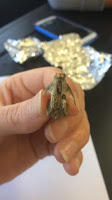 |
| Owl Pellet |
 |
| Skull Top View |
The owl pellet that we dissected ended up having a vole skeleton. Moles and voles are very similar, but we felt that the skeleton was a vole considering the scapula had a more defining corner instead of a curve. Although the pellet was only 4.7 cm long and 2.6 cm wide, we were able to find many bones. The skull and mandible that was produced were shaped like a voles, as well as many of the other bones that we extracted such as the forearm and scapula. It also consisted of many ribs, vertebrae, and tiny bones that were most likely phalanges or carpals. In all, our pellet weighed 6.62 grams.
 |
| Skull Bottom View |
As you can see in the picture of the whole skeleton put together, there are many bones that are similar to that of a human. First, the scapula's (aka shoulder blades) look very similar. Also, the vertebrae are categorized by the lumbar, thoracic, and cervical vertebrae. The Lumbar vertebrae are larger than the other two, just like with that of the human vertebrae. You can also see that the vole has a hip socket (black circular hole medial to the spine) where the femur will rotate.
Although, I oriented the bones like that of a human skeleton, the vole's skeleton should be oriented more on its side so that the legs and arms are overlapping. Or course, that would make the skeleton more confusing to look at. In taking a look at the skull of the vole, you can spot another difference. The eye sockets are located on the sides, whereas on a human, they are located in the front.
This lab was both fun and difficult. It was fun extricating the bones from the pellet, although they were very fragile. It was difficult to piece them together since many of them were broken, as well as discovering what kind of organism it was. The bones were very similar to each other. I enjoyed this lab, and I hope you enjoyed reading about my experience!
Thank You!
 |
| Mole Skeleton |
| Human Skeleton |